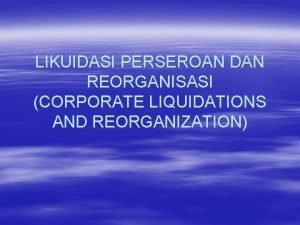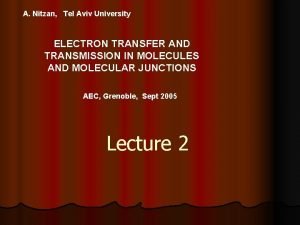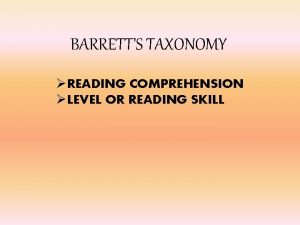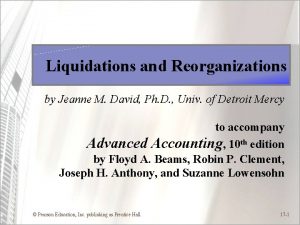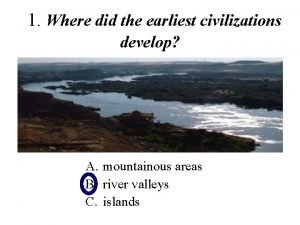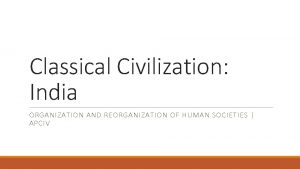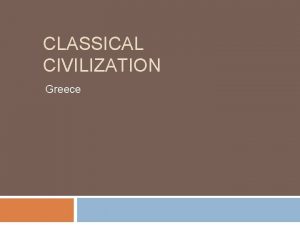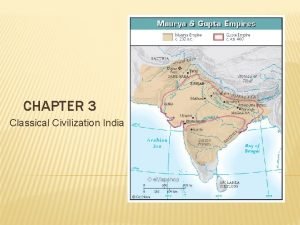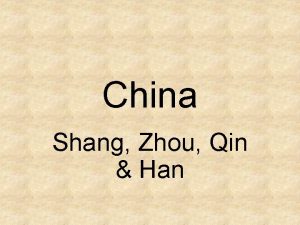CLASSICAL CIVILIZATION CHINA Organization and Reorganization of Human








- Slides: 8

CLASSICAL CIVILIZATION: CHINA Organization and Reorganization of Human Societies | APCIV

CHINESE FOUNDATIONS Xia Dynasty: c. 2070 -1600 BCE mostly legendary Shang Dynasty: c. 1600 -1046 BCE solidified several early Chinese traditions Distinctive “Chinese” identity Intellectual belief in a basic harmony in nature A balance with an opposite: a yin and a yang (a hot for a cold; a male for a female) Philosophically, one should find their way (called Dao) to relate to this harmony Avoid excess and appreciate nature’s balance Humans and institutions existed within this world of balanced nature Mediterranean philosophy would propose an existential world Chinese history is unique in that these foundations remain well-integrated Despite internal and external conflict

PATTERNS IN CLASSICAL CHINA Dynastic cycles: a family of kings whose power would rise and fall Chinese view of global “cycles” rather than Western time progression The Zhou Dynasty: 1029 -700 BCE Displaced the Shang from the north; assertion of divine support of leaders: the Mandate of Heaven Issues with centralized state: ruled through aristocrats and alliances – decentralization Feudalism: land power granted in exchange for tribute and soldiers: danger Successful agricultural development: wheat in the north and rice in the south – population boom Promoted linguistic unity: Mandarin Chinese – world’s largest unified group of speakers This unity explains why, when the Zhou began to collapse, scholars could speak to a social unity Confucius wrote addressing a core “Chinese” culture This was the Warring States Period, as decentralization became unmanageable: 402 -201 BCE Qin Shi Huangdi: brutally unified China via centralization: nobles left land to join his court China would be administered by a bureaucracy under a powerful emperor Began the Great Wall of China: 3, 000 miles; expanded south to Hong Kong Instituted a nation-wide census; standardized coinage and measurements (for roads and carts) Expanded building projects, production, and unified the language He was however, a brutal and paranoid leader

POLITICAL INSTITUTIONS The Qin Dynasty did not last long: 221 -202 BCE – peasant revolts upon death The Han Dynasty: 202 BCE – 220 CE – established by a peasant (Liu Bang) Improved the efficiency of the bureaucracy and opened it to all Chinese A central authority to regulate codes for the empire Enforced by officials throughout the empire: this system would be replicated by other regions (still used in China) The effectiveness of this system is dependent upon those regulating it (periods of good and bad) By the end of the Han, 130, 000 bureaucrats ran this system (. 2% of the population) Wu Ti (140 -87 BCE) established a civil service exam to hire talented officials (Merit System) A growing class of scholar-bureaucrats and a culture of intellectualism thrived Expanded power to Korea, Indochina, and Central Asia Wu Ti enforced peace throughout Asia – hegemony Trade links to Parthia and the Roman Empire A time of immense stability and prosperity for China (granaries full, effective building, huge population) No other political system until modern times had such a capacity to reach the needs of all people

DAY 2 APCIV | Classical Civilization: China

RELIGION AND CULTURE Chinese thought focused more on a harmonious earthly life as opposed to the nature of gods and the divine Social stability, cohesion, and tradition (chopsticks introduced during Zhou: etiquette) Confucius 551 -487 BCE: stressed political virtue and good government – Analects Chinese thought unique in that it was/remained secular and not religious Chinese intellectuals distasted religious mysteries but savored good manners Respect for social superiors, from father to statesman: a balance of social order A system of social ethics: do unto others as your status and theirs dictates with loyalty to the community Filial piety; leaders should view those they lead as children – benevolence in exchange for respect Development of state Legalism: pragmatic ruling of an authoritarian state Education was frivolous to a well-run state: was not as popular as Confucius Laozi developed Daoism alongside Confucius: similar with mysteries of nature Spiritual focus on the Dao, with a removal from society: the worldly was not important No religious buildings as in the rest of the world, but science thrived (astronomy, 365. 5 day calendar, a primitive seismograph, mathematics, and music – all for practical implementation)

ECONOMY AND SOCIETY As with all societies, divisions between rich (access to wealth and culture) and poor (access to production of wealth and labor) Upper-class administrators: 2% of population; lower-class providers: 98% The south constituted the largest rice-production, run by small villages (plow/harness invented c. 300 BCE) Peasants were not the lowest class: a class of individuals who moved goods (unskilled labor) A “trade” class never fully emerged due to a social stigma on lives of “moneymaking” (Osaka example) Social status was usually hereditary, however the merit system allowed for some mobility 3 main Chinese social classes Land-owners and bureaucrats (mandarins) Laboring masses (peasants and artisans): a life of labor, but some freedoms Unskilled labor force: unfairly punished for crime and required to wear green scarves Slave labor was present but very limited as population surplus meant labor was always available Technology increased production and efficiency Pulleys, lamps and gears for mining; water-powered mills invented; paper for records and money Compared to Europe and western Asia, China was and remained far superior in technology and implementation Women were subordinate but could wield power through sons, some had considerable power

HOW CHINESE CIVILIZATION FITS TOGETHER Social family structures were linked to economy and political goals (unity) Much of this culture and technology developed on its own (no outside influence) Saw the outside world as barbaric and something to avoid (the Great Wall) No desire to teach the rest of the world: missionary spirit was lacking Rare acceptance of foreign ideas (Buddhism a rare exception with profound effects) A unique view of society as a whole as opposed to private/public sectors Has remained the only continued ancient culture to this day Has held 1/5 of the world’s population since the last centuries BCE Strict discipline but also benevolence as a lesson/warning Story of late Han torture of criminal who refused to confess, then bathed and fed and treaty kindly: he then confessed his gang Variations in approach, whether philosophical or political, were uniquely unified by common classical roots This “wholeness” helps explain China’s immunity to outside influence whilst maintaining creativity

